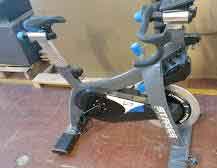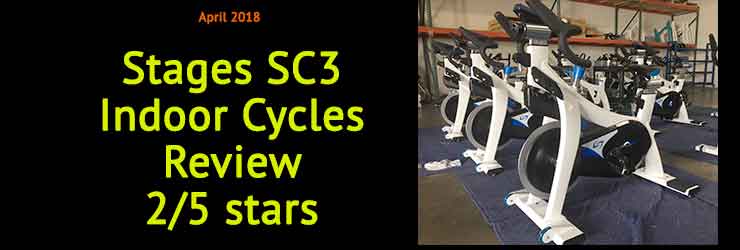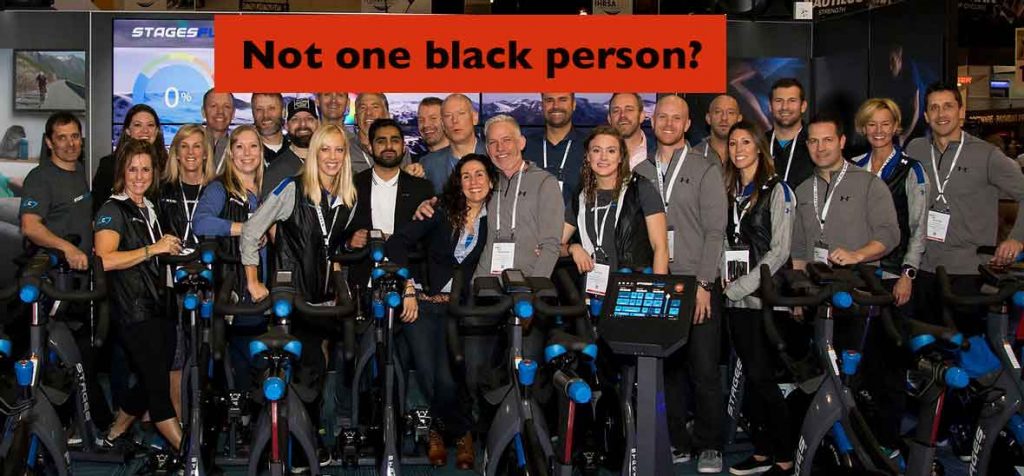Indoor Cycling Magazine would be considered crazy if 100% of our reviews were positive.
Our readers and fans want us to be professional and balanced and not want us to act like mindless cheerleaders.
Secondly. Many of you are aware that we are leaders in Instagram for Indoor Cycling. Our account known as @SpinClassSociety receives thousands of views every week. On Instagram we have posted over 100s of positive posts and have helped over 100 instructors and studios. Moreover. The majority of the time the communication is friendly and professional.
After many of us have witness the inequality and injustice that our Black brothers and sisters have suffered we have all become encourage to join their very noble cause. Which brings us to joining them in seeking justice and equality.
Let us begin with agreed upon facts. There are 100’s of companies who have been reprimanded for their lack of racial diversity and fairness. Many have been caught for their prejudice and bias and at best APPEARING as bias and prejudice.
Another agreed upon fact is that there are companies in the Indoor Cycling Industry. Such as Stages Indoor Cycling which manufactures and sells indoor cycling bikes. Now. Please notice Stages Indoor Cycling Company employee team photo:
You will notice that there is not one black person. What if there was not one woman? It would be all over the media if there was not one one woman. Which is why we felt compelled to go public.
Jim Liggett, the ceo of of Stages Indoor Cycling must be held accountable and issue an apology.
As such. It is ours’ and everyone’s moral and civic duty to make public alleged or actual acts of bias and prejudice.
If you think that is egregious and raises a red flag wait until you hear what a “Stages Master Instructor” did to a non-white citizen recently.
In Vancouver. A non-white citizen was threatened and harassed by a skinhead. As you will see from the video, when the non-white citizen took out his phone to video tape, the racist ran away like a shameless coward.
However when we complained to Angela Straker a Stages Master Trainer. Instead of apologizing she engaged in a hate crime and tried to have the police intimidate the non-white citizen. However it back-fired. The police saw her deception and malice and instructed the non-white citizen of her malice and deception.
As such we invite you to help us seek justice and demand the removal of Angela Straker. She is a Master Coach for Stages in Canada. I myself, a middle-eastern, have been treated extremely adversely at her hands. Every CANADA DAY we stand up for equality and diversity. Which is even more reason to take action against inequality, prejudice, and lack of diversity. Jim Liggett, the ceo of of Stages Indoor Cycling must be held accountable and issue an apology.
So that was the appetizer when it comes to Stages Indoor Cycling. Now likes move to main course.
Now likes move to main course.
You would think that the folks at Stages Indoor Cycling would at least try to appear professional and respectful. Even more when the
founder of Indoor Cycling reaches out to them. But again, we found out the truth. Recently when we reached to, Will Grossman, the head of sales for Stages Indoor Cycling we thought Mr. Grossman would at least show a cubit of respect and reply. We clearly said that we are the leaders in the Indoor Cycling Industry and even showed him a picture of his social media team encouraging us to reach out to him. We offered Mr. Grossman an opportunity to reach more people with their new “at home bike”. All we asked for was one bike to review. However. Either Angela Straker either slandered us to him or he does not consider non-white business owners worthy of a reply. We even had someone send hime a test email and Will replied 3 times in 30 minutes.
Jim Liggett, the ceo of of Stages Indoor Cycling must be held accountable and issue an apology. Is Stages Indoor Cycling located in Colorado hope of Aspen Colorado, a sanctuary company that permits this kind of mean and immoral conduct?
Just a quick reminder that this is how Indoor Cycling Society is known for
So folks. To conclude. Even a grade 5th child will conclude that it is not wise to give your business to Stages Indoor Cycling. We thank you for joining a good cause and only support companies that promote professionalism, equality and LOVE.
WE ARE DONE. HOWEVER. SOME OF YOU MIGHT WANT TO READ MORE. SO WE WILL LEAVE YOU WITH A REVIEW OF THE STAGES BIKES BELOW. I HOPE THAT HELPS.

Indoor Cycling Magazine was founded by real humans who are also consumers that value quality and customer service. Which is why so many people follow us and respect us. For example if we worshiped one brand and acted like lap-dogs that would be an insult to our integrity and to yours. However the other side of the coin is that sometimes we will disappoint people because we are not cheerleading their favorite bike or studio. But at the end of the day most people realize that and support us because they know we are authentic and professional.
On the topic of authentic and professional we found Stages Indoor Cycle management extremely unprofessional and unauthentic.
We are sure everyone agrees that the Stages bikes cost over 2000 dollars, not 200 dollars, but over 2000 dollars. Therefore the Stages management such as the head of sales Les Wiehe must not treat authentic and professional people like us with such recklessness and ignorance. It has been over a year and we still have not received a reply when we requested that they send us a bike for us to review. Remember. We are not a Tennis magazine or a Bowling magazine but an Indoor Cycling Magazine in which 1000s consider us leaders in the industry. Not only that we also own Instagram.com/IndoorCycling, and Twitter.com/IndoorCycling, and Pinterest.com/IndoorCycling, and Facebook.com/IndoorCyclingCentral. However. When we contacted him, he had this highflier attitude who did not care that consumers want an honest review before paying over 2000 dollars for a product. Even if he replied with “no thank you” that would have meant something, even our worst enemy would agree.
the Stages management such as the head of sales Les Wiehe must not treat authentic and professional people like us with such recklessness and ignorance. It has been over a year and we still have not received a reply when we requested that they send us a bike for us to review. Remember. We are not a Tennis magazine or a Bowling magazine but an Indoor Cycling Magazine in which 1000s consider us leaders in the industry. Not only that we also own Instagram.com/IndoorCycling, and Twitter.com/IndoorCycling, and Pinterest.com/IndoorCycling, and Facebook.com/IndoorCyclingCentral. However. When we contacted him, he had this highflier attitude who did not care that consumers want an honest review before paying over 2000 dollars for a product. Even if he replied with “no thank you” that would have meant something, even our worst enemy would agree.
However. Let’s keep this short and sweet. Below you will see honest reviews of the Stages SC3 Indoor Cycle. After reading those reviews please feel free to contact Stages “sales department” and ask them for a reply or if you already have a Stages bikes ask them for repairs or a refund. Sincerely, Indoor Cycling Magazine
Les Wiehe : 435-659-9114 : lwiehe@stagescycling.com
Let’s begin with a short review from a studio owner who owns 40 bikes.
We have had 40 SC3’s up and running now for about a year. To give a picture I would say 90% of the users are long term regulars and are superfit. Everyone tries to be positive, but, sadly I am sorry to say the SC3 is just not cutting it. There are numerous problems coming up on a daily basis and it’s getting worse. These bikes are getting hammered for about 4 hours each day – and I’m afraid it’s looking like they weren’t designed for this. Most frustrating of all, is that the fancy screen data is a total waste of time. Why? well every bike is giving different readings, this is despite many attempts by various bodies to reset. Early on everyone liked the screens, but sadly this didn’t last long and everyone now has given up on them. So basically now with no idea where you, the whole class has to be completed by flicking the gears about and just ‘feeling’ it. It will be interesting how this will all end. To finish, I would say nearly all the members at my gym are not pro cyclists, they just need a good sturdy bike with easy settings, good gears and a reliable bike readout which they can understand and try to improve on. IMO the SC3 does not deliver this.
The next review is longer and is from Case Bridge
Whilst the body of the bike really does look smart, some of the extremities look out of place = the massive oversized ‘antlers’, presumably designed to mimic the brake hoods whilst providing the feel of aerobars (if indeed aerobars were shoulder-width apart) look plain weird and feel like a relay baton in your hand, whilst the platform style pedals would look more appropriate on a mountain bike (although I have heard anecdotally that they provide a nicer feel for non-cleat users than the cage style alternatives). The black shell cover of the drive train does also appear to be an absolute magnet for dust, but this is nit-picking.
Personally, I’ve also found the bike un-necessarily uncomfortable – a hard seat might produce performance in the real world, but there is little justification for it when stationary, apart from ‘replicating the feel of the real thing’ argument. I had initially assumed that this also explained the less than smooth pedalling sensation, as there is a very noticeable feeling on the crank when pedalling against higher resistance, but getting out on my road-bike I certainly don’t feel this sensation in everyday riding. Perhaps this is an unavoidable consequence of these types of power meters (which admittedly I’ve never experienced on a real bicycle), but it does leave the studio at our gym whirring at a much louder background level than previously. Hardly a massive problem mind, but a clunky feel for something claimed to be a “frictionless resistance system” and even a “low conversational volume” is more than we’d been accustomed to in the studio at my gym.
 The main downfall with the SC3 comes in terms of functionality, with two seemingly minor issues significantly undermining it’s performance in studio based, music-driven classes. The computer, for all it’s brainy ability to calculate and produce so much data, is surprisingly slow, at least in terms of the display, which seems to suffer a lag of 1-2 seconds when it comes to large changes in cadence – which can be quite frustrating when accelerating from a simulated climb to an effort of faster but sustainable rpm. On several occasions, over multiple classes, I’ve massively over-shot the target cadence as my legs make the transition from 60 to 110rpm much quicker than the computer acknowledges; when I see the first reading of say 85rpm I push faster, faster still when I see 100rpm, only to see the screen eventually catch-up to my legs at 130, by which point I’ve potentially given too much and struggle to complete the desired effort. Added to this, the buttons on the display feel somewhat outdated, clunky micro-switches under a rubber cover, like the ZX Spectrum 48k, a cherished vestige from the past – which detracts from one of the heavily-sold features of the Stages package, as on numerous occasions I found that a combination of tiredness, sweaty fingers and these unforgiving buttons meant that I had failed in my attempt to end the ‘stage’ recordings, and then once I found this to be a recurrent problem, a secondary issue of impatient-uncertainty arose as this lag in the screen display fooled me into assuming I’d again not registered a button press, when in fact I had, so whilst the machine was getting around to changing the display, I would again press the button, which would presumably end the newly-started stage. Given that the data file (for all it’s geeky goodness) only displays the total workout results at the very end (and yes, moving these headlines to the first rows of the thousands would be a very nice improvement), any un-necessary extra stage breaks only exacerbates the mess.
The main downfall with the SC3 comes in terms of functionality, with two seemingly minor issues significantly undermining it’s performance in studio based, music-driven classes. The computer, for all it’s brainy ability to calculate and produce so much data, is surprisingly slow, at least in terms of the display, which seems to suffer a lag of 1-2 seconds when it comes to large changes in cadence – which can be quite frustrating when accelerating from a simulated climb to an effort of faster but sustainable rpm. On several occasions, over multiple classes, I’ve massively over-shot the target cadence as my legs make the transition from 60 to 110rpm much quicker than the computer acknowledges; when I see the first reading of say 85rpm I push faster, faster still when I see 100rpm, only to see the screen eventually catch-up to my legs at 130, by which point I’ve potentially given too much and struggle to complete the desired effort. Added to this, the buttons on the display feel somewhat outdated, clunky micro-switches under a rubber cover, like the ZX Spectrum 48k, a cherished vestige from the past – which detracts from one of the heavily-sold features of the Stages package, as on numerous occasions I found that a combination of tiredness, sweaty fingers and these unforgiving buttons meant that I had failed in my attempt to end the ‘stage’ recordings, and then once I found this to be a recurrent problem, a secondary issue of impatient-uncertainty arose as this lag in the screen display fooled me into assuming I’d again not registered a button press, when in fact I had, so whilst the machine was getting around to changing the display, I would again press the button, which would presumably end the newly-started stage. Given that the data file (for all it’s geeky goodness) only displays the total workout results at the very end (and yes, moving these headlines to the first rows of the thousands would be a very nice improvement), any un-necessary extra stage breaks only exacerbates the mess.
This, of course, wouldn’t be near the problem it is, were the mechanisms around setting the resistance better….
Stages have equipped the SC3 with a dual-layered resistance system, a twist-dial on the downtube with an overdrive lever, named the “Sprint Shift”, which provides two “macro increments” in addition to the continuous resistance changes available on the blue twisty knob. Presumably, the “sprint shift” is designed as an allegory to the forward chainset, allowing you to jump up into the big ring whilst the blue knob provides unlimited choices as a rear cassette. Whilst real bike gearing does offer discrete variations in resistance level, fundamentally as a training tool, having infinite variability in resistance is a good thing. However, the major, major issue with the system is the omission of feedback as to what resistance you have selected, providing uncertainty and difficulty for future replication. More on this later.
Unfortunately, I’ve yet to see the potential of this “Sprint Shift” lever realised, either in principle or function. Firstly, this feature in some ways takes away from the benefits that the continuous resistance provides, as now instead of infinite gears, you have but 3 – and whilst I’m not sure what the exact relationship is between knob-twists and these “macro increments” (I’ve heard suggestion that each macro is equivalent to two-full rotations of the knob), the likelihood is few people will sit perfectly into a convenient ability level that makes these jumps appropriate for them, without fiddling with the blue knob (further complicating the issue of remembering where you had the resistance set when jumping between effort types). This is worsened by a design flaw whereby, on occasion, the knob, which moves position with the lever when you macro-adjust upwards, gets a bit stuck and doesn’t always ratchet-back, and you find yourself about 1/8 of a turn ‘heavier’ having taken the lever up the two notches then back again. Couple this with the potential to knock the knob when you’re grasping at the lever (remember, we are often attempting this whilst pedalling at high exertion), or even turning the thing the wrong way (I can’t be the only person who’s had to think-through “lefty-loosey, righty-tighty, having second-guessed myself under reduced-oxygen flowing to the brain), there’s a lot that can reduce the likelihood of you accurately remembering what you did, and when (and indeed my better experiences have come when abandoning the idea of the lever entirely).
Say, for example, you’ve set the blue knob at 12 O’clock, after 4 complete clockwise turns from the position of least resistance (1040 degrees of rotation, if only this were displayed!), and you’re pedalling at a cadence of 115rpm, for 3 drives of 30 seconds. At the end of the first drive, you decide you could have gone harder, so adjust the knob a half-turn to the right. Then, during the effort you notice you’ve over-reached yourself, and need to wind it in. You reach awkwardly between your legs to the downtube, where road bike gears haven’t been situated for the best part of 3 decades, and twist the knob until the resistance feels correct, without your rapidly moving knees knocking your arm so that you take off far too much, and then somehow, often in the darkened room of a studio class, log into your brain the position of the knob, in order to compare yourself in future weeks (nb. I am fully aware that this point will most likely be countered by the availability of Power readings in Watts, however, as these are taken by the force on only the left crank, these vary depending on the uniformity of the pedal stroke. This can be easily shown when you pedal at a consistent cadence at a constant resistance, and watch the wattage fluctuate – pedal entirely with your left leg and the Watts skyrocket, whilst pedalling just with the right leg and the screen goes blank once the wattage dips below a certain threshold, despite the maintenance of overall pedal speed).
It strikes me that there are myriad possible readings that could be provided to illustrate the rotational position of the resistance knob (e.g. degrees, clock numbers, even arbitrary ordinal distinctions such as “alpha”, “beta” and “Steve”), and whilst I appreciate that these will always be limited and somewhat of a simplification, it doesn’t seem outside of the ability of a company that can produce a power meter sufficiently impressive to meet the exacting standards of the most scientifically discerning and well-funded team in the pro-peloton, and would be of great benefit to users, who could then adjust the level of resistance with more certainty and less guess work.
At this point, I anticipate advocates of the SC3 will be screaming at the idiocy of missing the potential benefits provided by the wattage, but I simply cannot see how this can be used to define efforts in a studio class – the instructor cannot possibly be expected to provide wattage targets for each individual, and whilst one could put the study time into ones’ own performance, using the plethora of spreadsheet data available post workout, even the knowledge that I could produce x watts for y seconds at z cadence, tweaking the resistance knob (with the aforementioned issues of cadence display lag) until I’m hitting the prescribed power target (with the also aforementioned fluctuation based on uniformity of pedalling across the legs) is the cycling equivalent of having spotters remove or add plain weight plates labelled mysteriously with question marks, as you attempt to squat an bar of unknown mass.
This might be fine if one has, say, a Tim Kerrison calculating performance targets for you, but in a studio class you are exercising to music, given a cadence as a target and a duration of effort – you need to be able to reliably set your resistance level in order to monitor progress between classes and over time. This seems to be where Stages as a company have failed to deliver a really top-level studio bike, and this is the great disappointment, as it had the potential to do so, and given how well they’ve resolved technical aspects in the more problematic ‘real-world’, they certainly would appear to have the talent to do so.







